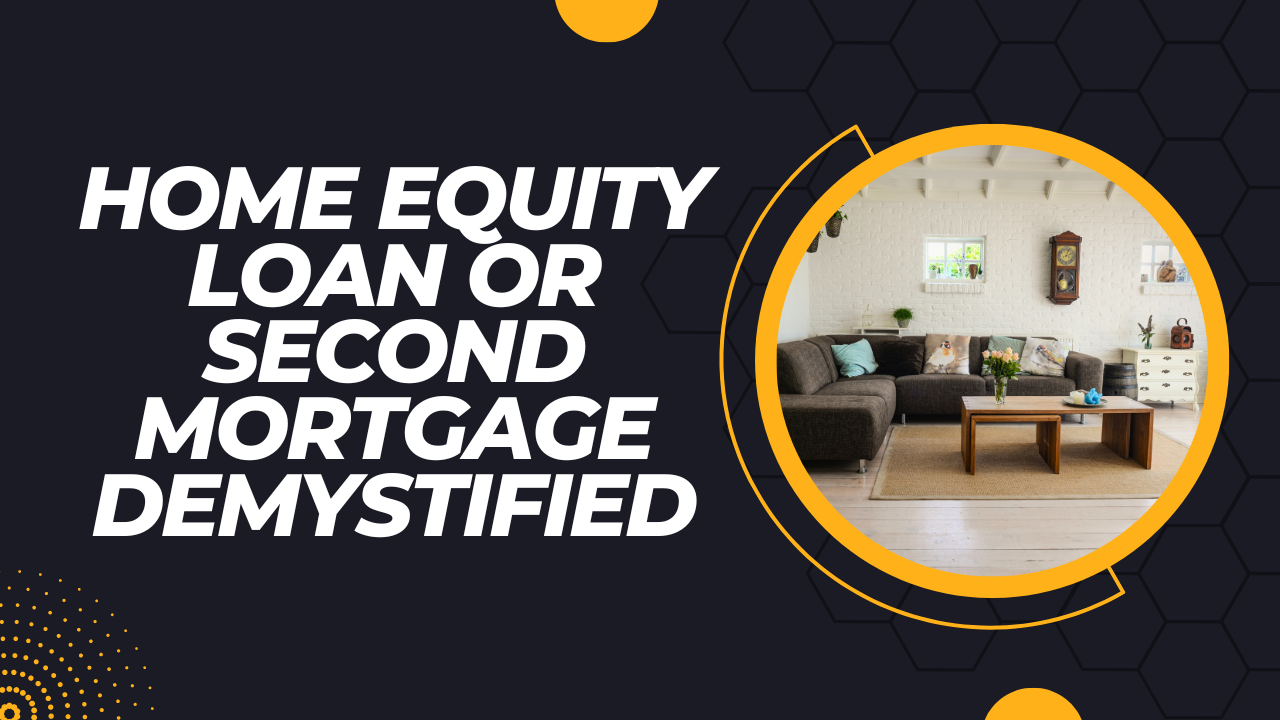When homeowners need to access the equity built up in their property, they often consider options like a home equity loan or a second mortgage. These financial products can be confusing, so it’s essential to demystify their differences and benefits.
The Concept of Home Equity
Before delving into home equity loans and second mortgages, understanding the concept of home equity is crucial. Home equity refers to the portion of a property’s value that the homeowner truly owns.
Home equity is an asset that grows over time as the homeowner pays down the mortgage or the property’s value appreciates.
In the subsequent sections, we will explore home equity loans and second mortgages in detail, providing insights into their features, differences, and practical applications.
Home Equity Loan Explained
A home equity loan, also known as a “second mortgage” or “equity loan,” is a loan that allows homeowners to borrow money using the equity in their property as collateral. These loans are typically fixed-rate and paid out in a lump sum, providing borrowers with a one-time payout that they repay over a predetermined period.
Key features of a home equity loan include:
- Fixed Interest Rate: Home equity loans usually come with a fixed interest rate, providing borrowers with predictable monthly payments throughout the loan term.
- Lump Sum Payment: The loan amount is disbursed to the borrower in a lump sum at the beginning of the loan term.
- Repayment Period: Home equity loans have a specific repayment period, often ranging from 5 to 30 years, depending on the lender and the loan amount.
- Uses: Borrowers can use the funds from a home equity loan for various purposes, such as home renovations, debt consolidation, education expenses, or other major expenses.
- Collateral: The property itself serves as collateral for the loan, meaning that if the borrower fails to repay the loan, the lender can foreclose on the property to recover the outstanding debt.
Second Mortgage Unveiled
A second mortgage, as the name suggests, is a secondary loan taken out against a property that already has an existing mortgage. It allows homeowners to tap into their home equity beyond what is owed on their primary mortgage.
There are two primary types of second mortgages:
-
Home Equity Line of Credit (HELOC):
- A HELOC is a revolving line of credit that allows homeowners to borrow against their home equity during a specified draw period, typically 5 to 10 years. During this period, borrowers can withdraw funds as needed, and they only pay interest on the amount borrowed.
- After the draw period ends, the HELOC enters a repayment period, typically 10 to 20 years, during which borrowers must make principal and interest payments on the outstanding balance.
-
Home Equity Loan (Second Mortgage):
- Similar to the home equity loan explained earlier, a home equity loan taken as a second mortgage provides a lump sum payment with a fixed interest rate and regular monthly payments over a predetermined term.
Differences Between Home Equity Loan and Second Mortgage:
While both home equity loans and second mortgages allow homeowners to access their home equity, the key differences lie in the way funds are disbursed and repaid. Home equity loans provide a lump sum payment with fixed interest rates, while second mortgages, like HELOCs, offer a revolving line of credit or a lump sum option with more flexible repayment terms.
Key Differences Between Home Equity Loan and Second Mortgage:
-
Disbursement Method:
- Home Equity Loan: Provides a lump sum payment to the borrower at the beginning of the loan term.
- Second Mortgage (HELOC): Offers a revolving line of credit during a draw period, allowing borrowers to withdraw funds as needed. Alternatively, a lump sum option may be available.
-
Interest Rate Structure:
- Home Equity Loan: Typically comes with a fixed interest rate, providing predictability in monthly payments throughout the loan term.
- Second Mortgage (HELOC): Often has a variable interest rate during the draw period, which may result in fluctuating monthly payments. The rate may convert to a fixed rate during the repayment period.
-
Repayment Terms:
- Home Equity Loan: Requires regular fixed monthly payments over the predetermined loan term until the loan is fully repaid.
- Second Mortgage (HELOC): During the draw period, borrowers may have the flexibility to pay interest-only or make minimal payments. Once the repayment period begins, regular principal and interest payments are required.
-
Use of Funds:
- Both Home Equity Loan and Second Mortgage can be used for various purposes, such as home improvements, debt consolidation, education expenses, or major expenses. The usage is dependent on the borrower’s discretion.
-
Risk and Flexibility:
- Home Equity Loan: Carries a fixed interest rate, providing borrowers with predictable payments but limited flexibility during the loan term.
- Second Mortgage (HELOC): Offers greater flexibility as borrowers can borrow against the credit line as needed during the draw period. However, the variable interest rate may lead to uncertain monthly payments during this period.
Pros and Cons of Home Equity Loan and Second Mortgage:
Home Equity Loan:
Pros:
- Fixed Interest Rate: Predictable monthly payments throughout the loan term.
- Lump Sum Disbursement: Provides a one-time payout, making it suitable for specific large expenses.
- Interest Tax Deduction: In some regions, the interest paid on a home equity loan may be tax-deductible, potentially reducing the overall cost of borrowing.
Cons:
- Lack of Flexibility: Once the lump sum is disbursed, borrowers cannot access additional funds without refinancing.
- Higher Interest Rates: Home equity loans may have slightly higher interest rates compared to first mortgages due to the added risk for lenders.
Second Mortgage (HELOC):
Pros:
- Flexibility: Borrowers can access funds as needed during the draw period, making it ideal for ongoing or unpredictable expenses.
- Lower Initial Costs: Borrowers only pay interest on the amount withdrawn during the draw period, reducing initial monthly payments.
- Potential Tax Benefits: The interest paid on a HELOC may be tax-deductible in some regions.
Cons:
- Variable Interest Rate: The interest rate may fluctuate during the draw period, leading to uncertain monthly payments.
- Repayment Transition: Borrowers must be prepared for the transition from interest-only payments during the draw period to principal and interest payments during the repayment period.
Risk and Considerations:
- Default Risk: Both home equity loans and second mortgages use your property as collateral. Defaulting on these loans could lead to foreclosure, where the lender may seize the property to recover the outstanding debt.
- Interest Rate Risk: For second mortgages with variable interest rates, borrowers face the risk of rising interest rates during the draw or repayment period, which can increase monthly payments.
- Additional Debt Burden: Taking on a home equity loan or second mortgage increases your debt burden. Assess your financial capacity to handle additional loan repayments without straining your budget.
- Loan Costs: Consider the fees associated with these loans, such as closing costs, application fees, and appraisal fees, which can impact the overall cost of borrowing.
- Usage of Funds: Ensure that you use the funds from these loans responsibly for planned expenses or investments. Misusing the funds can lead to financial difficulties.
- Loan Term: Longer loan terms may result in lower monthly payments but higher overall interest costs. Choose a loan term that aligns with your financial goals.
- Equity Erosion: Borrowing against your home equity reduces the ownership stake you have in the property. Consider the impact on your net worth and long-term financial plans.
Qualification and Approval Process:
- Credit Score: Lenders typically require a good credit score (usually above 650) to approve home equity loans and second mortgages. A higher credit score may result in better loan terms.
- Income and Debt-to-Income Ratio (DTI): Lenders assess your income and DTI to ensure you have the capacity to repay the loan. A lower DTI indicates better financial health.
- Equity Requirements: The amount of equity you have in your property is a crucial factor. Lenders often require a certain level of equity (e.g., 15% to 20%) to approve these loans.
- Property Appraisal: A professional appraisal determines the current market value of your property, which influences the loan amount you can qualify for.
- Documentation: Be prepared to provide various documents, such as proof of income, tax returns, bank statements, and property-related documents.
- Loan-to-Value (LTV) Ratio: Lenders use the LTV ratio to assess risk. A lower LTV ratio signifies a lower risk for the lender.
- Underwriting Process: Lenders thoroughly evaluate your financial information and credit history during the underwriting process to determine your eligibility for the loan.
FAQ’s (Frequently Asked Questions):
- Can I qualify for a home equity loan or second mortgage with bad credit?
- While it may be challenging to qualify with bad credit, some lenders specialize in offering loans to borrowers with lower credit scores. However, you may face higher interest rates and stricter terms.
- What is the difference between a home equity loan and a home equity line of credit (HELOC)?
- A home equity loan provides a lump sum payment with a fixed interest rate, while a HELOC offers a revolving line of credit with a variable interest rate during the draw period.
- Can I use the funds from a home equity loan or second mortgage for any purpose?
- Yes, you can typically use the funds for various purposes, including home renovations, debt consolidation, education expenses, or major purchases. However, responsible usage is recommended.
Conclusion:
Home equity loans and second mortgages provide homeowners with opportunities to access the equity in their property for various financial needs. However, it’s essential to carefully consider the risks and potential implications before taking on additional debt.
Also Read:
- How to avail loan against your insurance policy?
- 6 Ways on How to Choose the Best Personal Loan
- 7 Good Reasons to Get a Personal Loan
- What is Amortized Loan? How Does it Work, What are Loan Types ?




